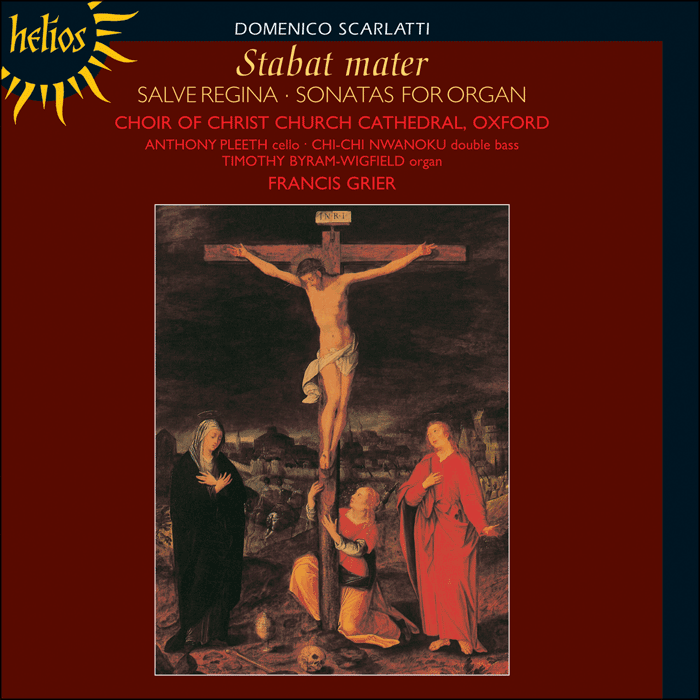Logowanie
Mikołaj - ten to ma gest!
Miles Davis, Horace Silver, Jay Jay Johnson, Percy Heath, Kenny Clarke, Lucky Thompson
Walkin'
20bit K2Super Coding - ale jak to brzmi!
Kasety magnetofonowe
Winylowy niezbędnik
ClearAudio
Double Matrix Professional - Sonic
najbardziej inteligentna i skuteczna pralka do płyt winylowych wszelkiego typu - całkowicie automatyczna
SCARLATTI, Christ Church Cathedral Choir, Oxford, Francis Grier
Stabat Mater
- Contents:
- 1. Stabat mater [26'44]
- Sonatas for organ
- 2. Sonata in D major Kk288 Allegro [2'53]
- 3. Sonata in G major Kk328 Andante comodo [5'25]
- 4. Sonata in C minor Kk254 Andante [3'54]
- 5. Sonata in D major Kk287 Andante allegro [2'14]
- 6. Sonata in C major Kk255 Allegro [3'59]
- 7. Salve regina [7'47]
- Christ Church Cathedral Choir, Oxford - choir
- Francis Grier - conductor
- SCARLATTI
I feel no hesitation in awarding this performance, and recording, full marks' (Hi Fi News) Today Domenico Scarlatti’s reputation rests largely on his enormous output of keyboard music (over five hundred esercizi, or sonatas). His operas are entirely forgotten, and of his sacred music only the Stabat mater (track 1), unique in its grandeur and depth of expression, is at all well remembered. It was probably composed between 1713 and 1719, while Scarlatti was maestro di cappella at the Basilica Giulia in Rome, and, in common with the many Italian and Italianate works of this period which set such emotive texts (Pergolesi’s Stabat mater, Lotti’s eight-part Crucifixus, and Hasse’s Miserere are other famous examples), its use of rich textures and unexpected harmonies within the seemingly austere framework of ten voices and continuo produces effects comparable to a painter’s chiaroscuro. To this end, Scarlatti combines sinuous chromatic melodies in a contrapuntal texture, as in the opening ‘Stabat mater dolorosa’, and achieves strong emotional contrasts by, for example, juxtaposing the striding scales of the choral section ‘Quis est homo, qui non fleret’ and the tortured suspensions of the soloists’ ‘Quis non posset contristari’. The diatonic counterpoint of ‘Fac me vere tecum flere’ seems to hark back to the prima prattica style inherited from Palestrina, while the florid duet ‘Inflammatus et accensus’ and the dance-like final ‘Amen’ betray truly operatic mannerisms. The fame and popularity of Scarlatti’s keyboard sonatas as one of the most idiomatic and yet most idiosyncratic collections of harpsichord music in existence have largely obscured the fact that a certain number of these works are also suitable for the organ – a few indeed were originally intended for that instrument. The pair Kk254 4 and Kk255 6 fall into the former category, their predominantly simple textures being well suited to the Baroque organ sound. Kk255 has two unusual annotations, indicating the composer’s use of musical mimicry: ‘oytabado’ (bar 37) probably deriving from ‘oitavado’, a popular eighteenth-century Portuguese dance, and ‘tortorilla’ (bar 64) meaning ‘turtle dove’. In one manuscript source (I-Vnm MS.9774) the sonata Kk287 5 is headed ‘Per organo da camera con due Tastatura Flautato e Trombone’ and its companion piece, Kk288 2, also has registration marks (I-PAc AG31412). Formally, both these pieces are organ voluntaries, neither being in the binary form with double bar which is standard in Scarlatti’s sonatas. Kk328 3 similarly falls into this second category, bearing the indications of registration ‘Flo’ and ‘Org.’ (‘flauto’ meaning ‘flute stop’, and ‘organo’ meaning ‘diapason’). Like the Stabat mater, the little Salve regina in A minor 7 is a work of Scarlatti’s first Italian period, having many similarities with the early keyboard fugue Kk41. Intimate and restrained in style, the six sections of the work again reveal a refined sensitivity to the text, ranging from the gentle, yet almost joyful ‘Ad te clamamus’ to the sorrowing chromaticism of ‘gementes et flentes in hac lacrimarum valle’ and the exquisite valedictory ‘o pia, o dulcis virgo Maria’. Nicholas Clapton © 1985






























